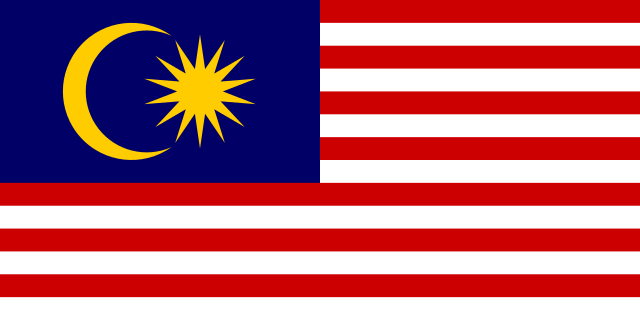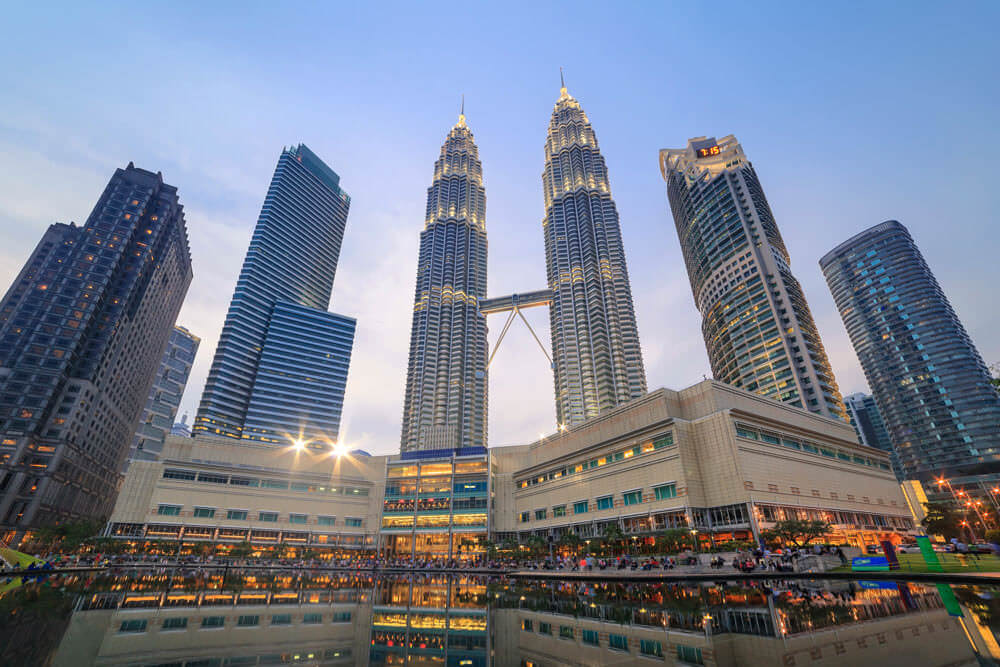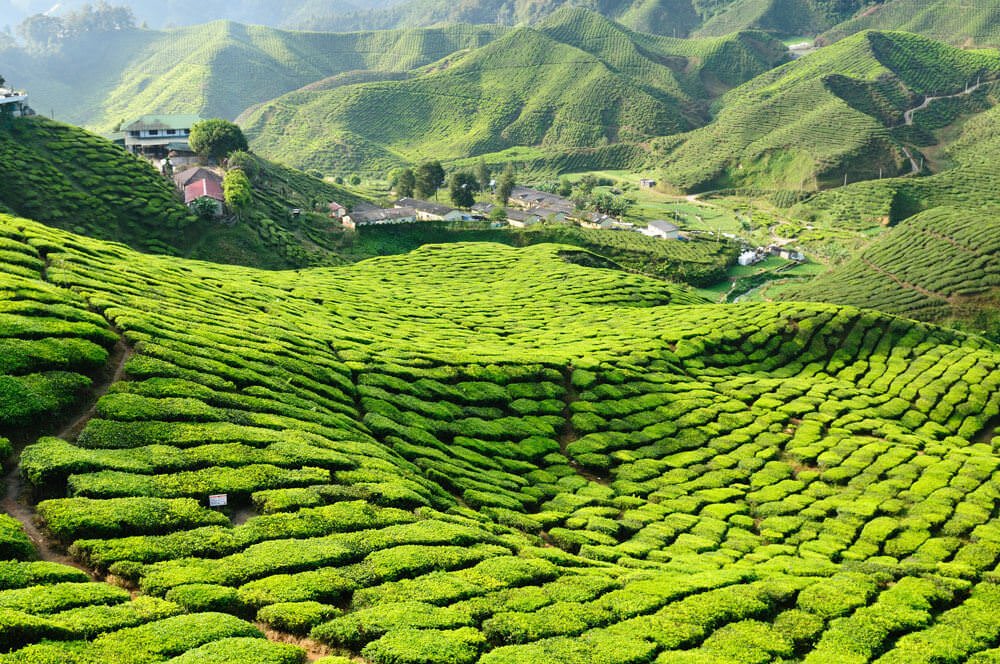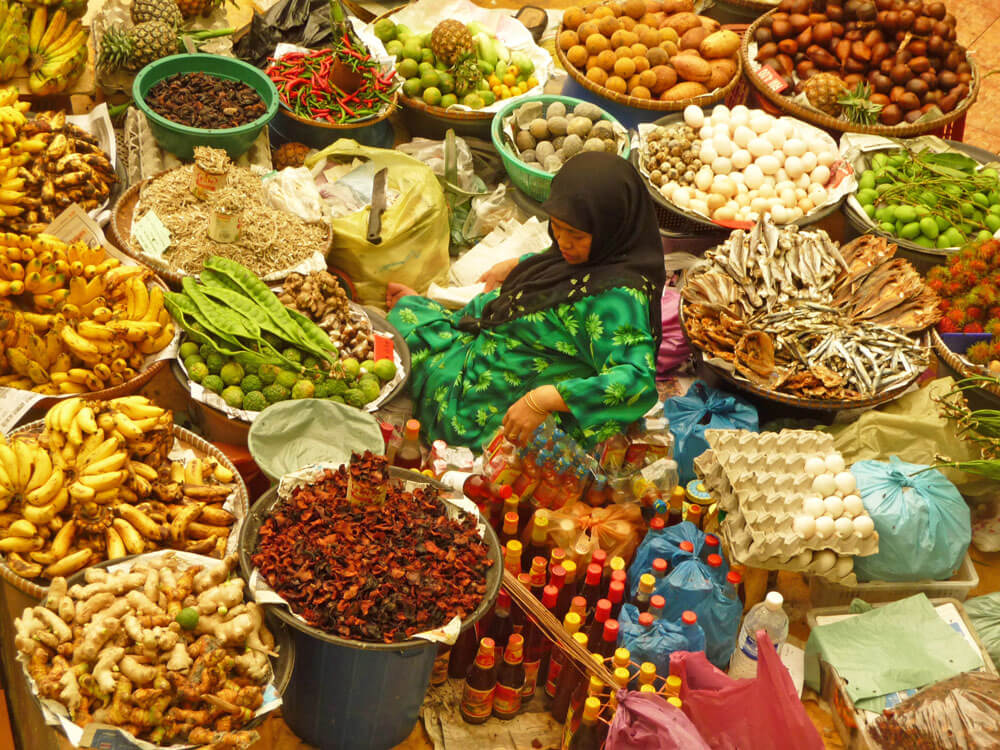Malaysia

Capital City: Kuala Lumpur
Population: 33,331,000 (2022)
Land Area: 330,411 sqkm
Official Language: Malay
Time Zone: GMT+8hrs
Currency: Malaysian ringgit (MYR)
GDP: 372.7 billion USD (2021 est.)
Main industries: Wholesale and retail trade, food and beverages, accommodation
Principal exports: Electrical appliances, chemicals, petroleum, natural gas, palm oil
Malaysia is a southeast-Asian country amidst the South China Sea. Malaysia consists of two peninsulas, which sit astride the South China Sea. West Malaysia is located on the Malay Peninsula and hosts the nation’s capital, Kuala Lumpur. It shares its southern border with Singapore and its northern border with Thailand. Across the Strait of Malacca is Indonesia. East Malaysia is on the island of Borneo, with Indonesia to its south and Brunei to its north. The Balabac Strait separates Malaysia from the Philippines. Malaysia has a land area of 330,411 sqkm, with Peninsular Malaysia constituting around 40% and East Malaysia around 60%.
The environmental features of Malaysia are diverse, with over 60% of land covered by rainforest. Peninsular Malaysia is essentially several mountain ranges with coastal lowlands. East Malaysia has three distinct topographic features: a flat coastal plain, an inland hill-and-valley region, and a mountainous backbone along its southern border. Mount Kinabalu is the highest peak in the Southeast Asian archipelago. The two longest rivers, the Rajang and the Kinabatangan, are both located in East Malaysia. Malaysia has an equatorial climate with constantly heavy rainfalls and high temperatures. Floods, rainstorms, and monsoons are typical natural hazards in Malaysia.

Demographics
Malaysia has a population of 33 million, according to 2022 estimates. Due to Malaysia’s geographical position in the maritime trade path, it is home to a wide variety of ethnic groups. Slightly more than half (61.7%) of the population is Malays and indigenous people, while the Chinese constitute a fifth (20.8%), Indians a small portion (6.2%), and the rest are Pakistanis, Sri Lankans, Europeans, and others.
The national language, Malay, or officially Bahasa Malaysia, helps unite such diversity of ethnicities. Mandarin and English are also commonly spoken in Malaysia. The official religion of Malaysia is Islam. All Malays are Muslims by law. Most Chinese subscribe to concepts of Confucianism, Buddhism, Daoism, or other Chinese folk religions. Most Indians and Sri Lankans practice Hinduism. As such, Islam (61.3%) is the most popular religion in Malaysia, followed by Buddhism (19.8%) and Christianity (9.2%). Most of Malaysia’s population lives in urban areas, with only one-fourth living rurally. The majority of the population is concentrated in western Peninsular Malaysia.
History
Since Malaysia is divided between two regions, its development went down different pathways in history. Traces of human activity dating back around 40,000 years ago are found in northern Sarawak, confirming that Homo sapiens inhabited modern-day Malaysia. Evidence of Stone Age and Bronze Age civilisations is unearthed in Peninsular Malaysia, proving that it has been inhabited for more than 6,000 years. The first wave of migrants came from China and Tibet, while Indian traders and priests arrived several centuries later. Scant documentation suggests that about 30 small states rose and fell in Peninsular Malaysia in the 1st millennium CE.
In about 1400, the king converted to Islam and became a sultan. This attracted Muslim merchants on top of well-established trading ties with China. Hence, Malacca became a trading hub of Southeast Asia, facilitated by a stable government and a free trade policy. From the 15th century onwards, people who practice Islam and speak the Malay language identify themselves as “Malays”.
The Portuguese arrived Malacca in 1509 and invaded it in 1511. The Portuguese imposed high taxes and banned Islam. Thus, Malacca declined and was subject to repeated assaults by the sultanate of Aceh. In 1641, the Dutch seized Malacca and replaced the Portuguese. However, they could not revive the trade back to pre-European intrusion levels. North to Malacca, western influence was negligible in Malaya and Borneo. Wars erupted within and between sultanates frequently in the Malaya region until a confederation of nine small states, Negeri Sembilan, was formed in the 18th century. The peninsular became a prosperous trading port and attracted the ancestors of many present-day Malays.
The British first acquired the island of Penang via the East India Company in 1786. In 1819, the British further occupied the island of Singapore in the Strait of Malacca. In 1824, the British obtained Malacca from the Dutch and governed the three regions collectively as the Straits Settlements. In the 1870s, the British began to intervene in the internal affairs of Malayan sultanates through a system of British residential advisers. In 1872, North Borneo fell under British control, and the British ruled the territory as a protectorate until 1941. Sarawak also became a British protectorate in the late 19th century. In 1909, the British acquired other northern Malay states from Siam (now Thailand). Formal or informal colonial control was established over the nine sultanates, which formed British Malaya. Under British colonialism, farmers were pressured to shift from subsistence to cash-crop farming. Extractive economic activities helped Malaya become the world’s largest exporter of rubber and tin.
Japan invaded and occupied Malaya and Borneo during the Second World War. After Japan’s defeat in 1945, the British proposed to form a Malayan Union to integrate all Malayan territories except Singapore, an act that would undermine state autonomy. Malay nationalism began to rise. People protested against the proposal. This resulted in the formation of the Federation of Malaya in 1948. This triggered the discontent of the impoverished Chinese population, who then began a guerrilla insurgency known as the Malayan Emergency that lasted 12 years. On 31 August 1957, the Federation of Malaya finally achieved independence. Tunkun Adbul Rahman, the head of the United Malays National Organization (UMNO) became the first prime minister of independent Malaya. In 1961, elections were held in Borneo, Sarawak, and Singapore, all of which accepted merging with the new federation called Malaysia. On 16 September 1963, the Federation of Malaysia was established. In 1965, Singapore separated from Malaysia to become an independent republic due to its predominant Chinese demographics.
Key Dates
1400 The king becomes Muslim
1511 Malacca falls under Portuguese control
1602 Malacca falls under Dutch control
1824 Britain obtains Malacca from the Dutch
1881 Britain rules North Borneo as a British protectorate
1909 Britain acquires sovereignty over Malayan states and formed British Malaya
1941 Japan invades Malaya during WWII
1948 Guerrilla insurgency against the colonial government started
1957 The Federation of Malaya achieves independence
1963 Borneo and Sarawak join Malaya and forms the Federation of Malaysia on 16 September
1965 Singapore seceded from Malaysia

Legal System and Government
Malaysia is a parliamentary democracy with a federal constitutional monarchy. The federal state governs 13 states and 3 federal territories. Malaysia is the only rotating monarchy in the world where kingship rotates once every 5 years among nine sultans, who each rule a separate state. The parliament consists of the lower house, the House of Representatives, and the upper house, the Senate. The lower house is elected by universal suffrage, while the upper house is indirectly elected and appointed. The monarch appoints the prime minister from among the House of Representatives, who is usually the leader of the winning party. The monarch then appoints cabinet ministers on the advice of the prime minister. All cabinet ministers must be members of the federal parliament.
Malaysia has a dual-track legal system. The common law legal system operates in parallel with the Islamic Sharia legal system that only governs Muslim Malays. Under common law, the Federal Court is the supreme judicial organ that hears appeals from the Court of Appeal in Malaya and the two High Courts in Sarawak and Sabah. Subordinate courts have both criminal and civil jurisdiction. The main sources of law include the Constitution, legislation, court judgments, and secondary sources such as practice, customs, and tradition. Under religious law, the Islamic Sharia courts follow federal legislation. Muslim Malays are subject to religious and moral charges, normally in domestic family contexts.
Economy
Malaysia is an upper middle-income country and the 15th largest economy in Asia in terms of nominal GDP. Malaysia is a leading exporter of electrical appliances, parts, and components. In 2020, it ranked among the top 10 exporter countries in Asia. Malaysia has an average of 130% trade-to-GDP ratio since 2010, thus being one of the most open economies in the world. With consistent economic growth, Malaysia is forecasted to transit to a high-income economy by 2024.
The GDP of Malaysia reached a historic high of 372.7 billion USD in 2021. Malaysia maintained a steady GDP growth rate of 3.1% in 2021, demonstrating a solid recovery from COVID-19 disruptions. Malaysia’s GDP surged by 14.2% in the third quarter of 2022. Hence, experts predict that Malaysia’s GDP growth in 2022 is likely to exceed projections of 6.5%, contrary to the global economic downturn. This is largely due to the reopening of borders as the pandemic comes under control, which leads to an economic bounce back.
Malaysia’s economic growth in the past few decades is attributable to its economic diversification. In the early 1970s, the government implemented the New Economic Policy (NEP) and the New Development Policy (NDP) to redistribute wealth and privatise public-sector activities. Malaysia successfully transformed its economy from rubber and tin exportation to the manufacturing and services sectors. Currently, the services sector is the largest contributor to the country’s GDP, taking up 51.6%, followed by the manufacturing industry (37.7%) and agriculture (9.6%). Among the services sector, wholesale and retail trade, food and beverages, and accommodation account for the vast majority of revenue.

Investment Opportunities
Foreign investors tend to finance projects in the Malaysian manufacturing industry due to the sector’s success. Investments in electrical and electronic manufacturing have proven to be resilient and innovative. However, other areas of the industry could also benefit from foreign investment, including the aerospace sector. The Malaysian government has identified several key sectors that have enormous potential for economic development. For instance, the demand for aerospace manufacturing is likely to increase significantly within the next decade.
Malaysia’s technology market has seen several start-ups developing into successful businesses in the last few years. Innovation in technology sector is imperative for developed countries in today’s market to compete effectively with foreign economies which are investing heavily in the area. For example, investments into projects that seek to improve artificial intelligence or big data analytics in Malaysia are becoming increasingly important.